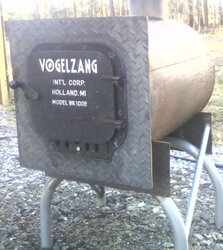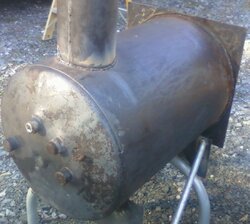Look-in for some help figuring out a problem with the wood stove I just built out of a old water heater. How I built it was I, cut the bottom out and welded flat steel to it, then I cut in a prefab door kit and a 6" pipe for exhaust. The problem is draft, anytime, when I light it, burn it or open the door smoke comes out the door. When I installed the 6" pipe I cut a whole, inserted the pipe and welded around it, the pipe sticks down on the inside about 5/8". The stove is also not getting enough air to burn either, if I crack the door it burns hard and I can close (slide) the door vent and cut the air off and kill the fire, with the door cracked. The door has a seal around it, I was thinking of removing it and trying that, allowing it to get more air.
The stove is setting in the drive way now for testing before I install it, I have tried it with 7 ft of pipe straight up and a 90 deg bend. Am I having these problems because of the outside air temp no natural convection?
Thanks for any help you can give me, been reading this forum for a long time and you guy's are great.
The stove is setting in the drive way now for testing before I install it, I have tried it with 7 ft of pipe straight up and a 90 deg bend. Am I having these problems because of the outside air temp no natural convection?
Thanks for any help you can give me, been reading this forum for a long time and you guy's are great.



